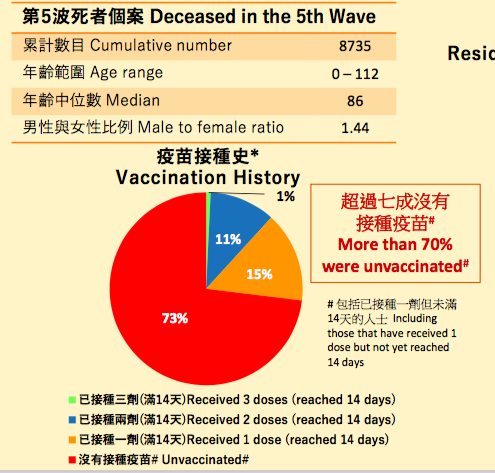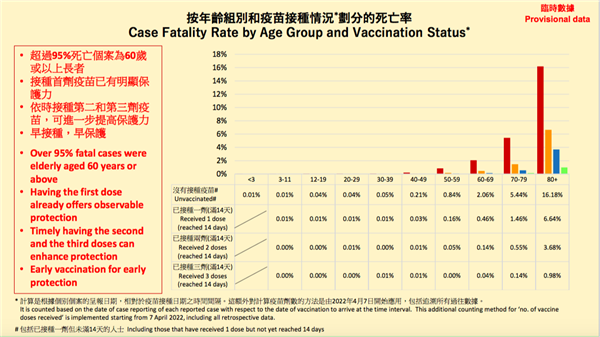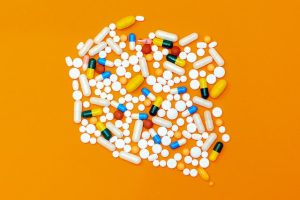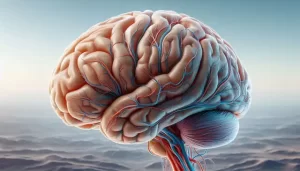Hong Kong: 3 doses of COVID-19 vaccine reduce the mortality rate by 98.7%!
- A Persistent Crisis: The Looming Specter of Drug Shortages in United States
- Rabies: The fatality rate nearly 100% once symptoms appear
- Human Brain Continues to Grow: Study Shows Increase in Size and Complexity
- CRISPR Genome Editing: From Molecular Principles to Therapeutic Applications
- Metformin Helps Immune System Better Recognize Cancer Cells
- Highlights of Prostate Cancer Research at the 2024 EAU Congress
Hong Kong: 3 doses of COVID-19 vaccine reduce the mortality rate by 98.7%!
- Red Yeast Rice Scare Grips Japan: Over 114 Hospitalized and 5 Deaths
- Long COVID Brain Fog: Blood-Brain Barrier Damage and Persistent Inflammation
- FDA has mandated a top-level black box warning for all marketed CAR-T therapies
- Can people with high blood pressure eat peanuts?
- What is the difference between dopamine and dobutamine?
- How long can the patient live after heart stent surgery?
Hong Kong: 3 doses of COVID-19 vaccine reduce the mortality rate by 98.7%!
Booster shots can “save” more lives?
Preliminary analysis of deaths in Hong Kong from the recent fifth wave of the outbreak has been released.
The report, which is provided by the Hong Kong Department of Health and analyzed by the Hong Kong Hospital Authority, shows that as of April 13, the median age of the deceased was 86, and more than 95% were 60 and older. And 73% of them were not vaccinated.
3 doses reduce the mortality rate by 98.7%!
 An analysis of deaths in Hong Kong from the fifth wave of the epidemic found that 73% of them were not vaccinated.
An analysis of deaths in Hong Kong from the fifth wave of the epidemic found that 73% of them were not vaccinated.
From: Official website of the Government of the Hong Kong Special Administrative Region
Hong Kong: 3 doses (booster) of COVID-19 vaccine reduce the mortality rate by 98.7%
Further analysis showed that the mortality rate of the unvaccinated group was 2.97%, and the mortality rate of the three-shot vaccine was 0.04%.
In other words, three shots of the vaccine can reduce the mortality rate by 98.7%. Even a single shot can reduce the mortality rate by 67.3%.
“This is the experience that thousands of elderly people in Hong Kong have exchanged for their lives. It’s real-world data, and I hope it can attract attention.” Jin Dongyan, an expert in virology at the University of Hong Kong.
The report calls for: “Any three-dose vaccine significantly reduces the risk of death, especially in older age groups”!
In fact, experts have been emphasizing the important role of vaccination in older adults.
As early as the beginning of the fifth wave of the epidemic, virology expert Chang Rongshan once proposed that vaccines are the best weapon to protect the human body. “Only vaccines can protect the human body 24 hours a day.” Especially the elderly, the older you are, the higher the risk. “The willingness to be vaccinated is high now, but it needs to be extended to the entire elderly population.”
At the beginning of the Shanghai epidemic, Zhang Wenhong, director of the Department of Infectious Diseases at Huashan Hospital Affiliated to Fudan University, also took Hong Kong as an example and proposed that the third vaccine would play an important role in preventing severe illness and reducing the fatality rate.
Especially the elderly, the elderly in nursing homes, if they do not get a third shot to boost their immunity, they cannot take off their masks. “Not getting vaccinated may not necessarily cause an accident, but most of the people who do have an accident are not vaccinated.”
Zhong Nanshan, an academician of the Chinese Academy of Engineering, is even more committed. In an online live broadcast for Nankai University on April 8, according to China’s “dynamic clearing” strategy, the suggestion given is to “use xenogeneic vaccines as sequential immunization”, which can not only reduce the Severe and fatality rates, and also reduce the progression of infectivity. And he himself has been vaccinated with the recombinant protein COVID-19 vaccine as a booster shot.
Why is the effect of one more dose of the COVID-19 vaccine significantly enhanced? Why are the most at-risk seniors slower to get vaccinated? Should the elderly at home not go out and have underlying diseases need this dose?
Booster shots that can “save” more lives
“Most of the fifth wave of epidemics are breakthrough infections.” Jin Dongyan wrote in a report summarizing the epidemic in Hong Kong, and the proportion of “majority” was 81.8%.
In January 2022, at the beginning of Omicron’s fifth wave of the global epidemic, some researchers conducted research on the structural basis of Omicron’s immune escape.
In the paper, the researchers noted that the new strain has 37 mutations in the spike protein. Every mutation in the spike protein, which binds to human cells, is worrisome.
There are 15 and 11 mutations, respectively, in the RBD region of the viral spike protein (S protein) that binds to the human body and the N-terminal structural NTD, which lead to severely reduced plasma neutralizing activity in previously infected or vaccinated individuals .
Of particular note is the RBD region of Omicron.
Previous research has proved that Omicron is easier to bind to human cells – the affinity of the “key” RBD and the “lock” ACE2 on human cells is about 2.4 times higher than that of the new coronavirus strain during the Wuhan epidemic.
This study further found that only one N501Y mutation on the RBD increased the binding ability of Omicron to ACE2 in human cells by 6 times.
In addition, general VOCs (focusing on variant strains) rarely mutate outside the regions related to new coronavirus infection and pathogenicity, such as RBD, NTD, and furan cleavage sites. Omicron has 8 mutations outside these three regions: T547K, H655Y, N764K, D796Y, N856K, Q954H, N969K and L981F.
These points all play an inhibitory role in vaccine immunity or infection immunity from different angles.
Under these combined effects, the Omicron strain is not only more transmissible, but also more easily able to cross the barriers of natural immunity and vaccine immunity, resulting in breakthrough infections.
With stronger escape ability, the protective ability of existing vaccines is significantly reduced.
An article published by Zhang Wenhong’s team on the preprint website on April 7 clearly stated that two doses of the inactivated vaccine are no longer sufficient to provide comprehensive protection against the new variant.
Booster shots, whether homologous or heterologous, can reduce the escape of Omicron from neutralizing antibodies.
This study also found that after the human body was naturally infected with Delta, the antibody titer against Omicron was much lower than the level of the booster vaccine.
That is to say, the neutralizing antibody elicited by the booster shot of the vaccine is higher than that of the natural infection. The researchers believe that “this may be related to the antigenic differences between the Delta and Omicron variants”.
Among the various sub-variants of Omicron, BA.2 is only more capable of spreading than BA.1, not immune evasion.
This report also pointed out that Omicron sublines, such as the three recently reported recombinant lineages (XD, XE and XF), were not significantly different from BA.1, BA.1.1, BA.2 and BA.3.
This also means that the widespread promotion of vaccine booster vaccination can still effectively prevent Omicron strain infection and severe disease.
This is also mutually verified with the latest research results of researchers at the University of Hong Kong and Zhong Nanshan’s team.
A study by University of Hong Kong researchers found that with neutralizing antibodies as an indicator, the protective power of two doses of the vaccine against Omicron was almost zero, and reached a new peak after the third dose.
Jin Dongyan pointed out to the principle of tiger olfactory analysis that this is mainly because after the body comes into contact with the antigen again, the antibody-producing cells that can bind to it will expand in large quantities, and the antibody will also mutate during this process, becoming more and more affinity. , the neutralization ability is getting stronger and stronger.
Academician Zhong Nanshan pointed out in the aforementioned online live broadcast that through the laboratory analysis of vaccine immunogenicity, it was found that after two doses of inactivated vaccine, the use of xenogeneic vaccine to strengthen the serum neutralizing antibody level, specific CD4+ (RBD polypeptide library) stimulation) activity, all achieved better effects than the three-shot inactivated vaccine.
The results of a Brazilian heterologous vaccination published by him also showed that the protection rate of the vaccine against infection dropped to 34.7% after 6 months of inoculation with two doses of Sinovac vaccine, and the rate of severe disease prevention was 72.5%.
At this time, if a dose of mRNA vaccine is strengthened, the effectiveness of the vaccine against infection surges to 92.7% after 14 to 30 days, and the rate of severe disease prevention reaches 97.3%.
Now Omicron spreads faster and more stealthily, often with community spread at the time of discovery. In this case, vaccination and the construction of immune barriers are undoubtedly very important foundations. In particular, Omicron can still be lethal to the elderly.
Protecting the elderly is key against Omicron
According to Jin Dongyan’s summary, 99% of the current outbreak in Hong Kong is mild and asymptomatic.
Nevertheless, the reality that cannot be ignored is that although Omicron is far less pathogenic than Delta, there will still be a certain proportion of patients with severe disease.
Wu Zunyou, chief epidemiologist at the Chinese Center for Disease Control and Prevention, once said that Omciron has caused more deaths than Delta.
The elderly are undoubtedly the weakest breakthrough.
The latest research shows that severe illness is likely to be related to the infection of immune cells by the new coronavirus.
Recently, researchers at Boston Children’s Hospital wrote that in the human body, monocytes and macrophages are the “outposts” of the human immune system, which can sense invading infections and make a series of responses to “kill” the invaders, but in Fcγ Under the mediation of the receptor, the new coronavirus may infect these two kinds of cells.
Although the “suicide counterattack” from these two types of cells will stop the infection, it will also trigger the pathogenesis of COVID-19 pneumonia and cause systemic inflammation.
The researchers found that about 6% of the monocytes in the blood of the dead cases were infected with the new coronavirus and died of inflammatory diseases; 1/4 of the macrophages in the lungs were dying, and further studies found that 10% of the monocytes and 8% of the monocytes were dying. of macrophages infected with SARS-CoV-2.
The researchers pointed out that severe disease caused by the new coronavirus, characterized by acute respiratory distress, can lead to the development of multiple organ failure and death in the elderly and patients with comorbidities.
Increased chronic inflammation is associated with aging, and comorbidities associated with severe disease and severe disease are associated with signs of inflammation.
The elderly have poor resistance and often suffer from underlying diseases, especially major diseases such as cancer. This inflammatory response may also aggravate their existing diseases. Because of this, they are the most at-risk groups in the COVID-19 epidemic.
This can also be clearly seen from the data in Hong Kong. Of the 8,735 deaths caused by the new coronavirus reported in Hong Kong as of April 13, 8,394 were elderly people over the age of 60, accounting for 96%. Among them, there are 6,208 people over the age of 80, accounting for about 71%.
The aforementioned research by experts from Boston Children’s Hospital also showed that the vaccine recipient plasma does not promote antibody-dependent monocyte infection.
It turns out that older adults without vaccine protection are even more at risk. The mortality rate of people over 80 years old who have not been vaccinated against the COVID-19 in Hong Kong is as high as 16.18%, which is 16.5 times that of people of the same age who have been vaccinated with 3 doses of vaccine; among people aged 70 to 79 years old, the mortality rate of those who have not been vaccinated is that of those who received 3 doses of vaccine 38.9 times that of the 60- to 69-year-old group, and more than 50 times that!

3 doses reduce the mortality rate by 98.7%!
From: Official website of the Government of the Hong Kong Special Administrative Region
In the fifth wave of the global epidemic in which Omicron is an epidemic strain, the number of infected people in Hong Kong exceeded one million; from January to March, the cumulative number of reported infections in 31 provinces and municipalities in China and the Xinjiang Production and Construction Corps reached more than 100,000; the number of infections in Shanghai is increasing day by day The number also exceeded 28,000 at one time…
Under such circumstances, vaccinating the elderly against COVID-19, especially booster vaccination, has become the most powerful weapon against Omicron and the decisive battle against COVID-19.
The current situation is be a “dilemma”?
However, many elderly people have not been vaccinated in time due to their high risk. In this regard, Jin Dongyan analyzed that as far as Hong Kong is concerned, there are many reasons why the elderly do not get vaccinated.
On the one hand, the epidemic situation has been few before, and they feel that there is no need to vaccinate; on the other hand, worrying about side effects is also an important reason.
Elderly people at high risk should be vaccinated, and they are worried that adverse reactions to the vaccine will cause bodily harm. This puts a lot of people in a dilemma.
“Inactivated vaccines are safer than mRNA vaccines, and more than 97% of people can be vaccinated.” Jin Dongyan told that there were some misleading information at the beginning, such as people who thought that people with immune problems and cancer patients could not be vaccinated, but later proved that are both wrong.
It can be seen that in the latest “Technical Guidelines for New Coronavirus Vaccination (First Edition)” issued by the National Health and Medical Commission, even patients with malignant tumors can be vaccinated against the COVID-19 virus.
Zhang Hongtao, a doctor of pharmacology in the United States, emphasized in the article that as long as these cancer patients are not having a fever or are in the acute treatment phase or under uncontrollable conditions, they can be vaccinated against the COVID-19.
At the State Council’s joint epidemic prevention and control press conference on April 1, Wang Qinghua only listed a few suspended vaccinations, including: fever or acute exacerbation of chronic diseases, Guillain-Barre, transverse myelitis and For some related diseases such as demyelinating disease, if the situation is not controlled, vaccination can be postponed.
It is a tragedy that thousands of elderly people in Hong Kong have passed away due to the epidemic.
In order that the tragedy will not repeat itself, Hong Kong is also vigorously promoting the COVID-19 vaccination.
Judging from the official website of the Hong Kong Special Administrative Region, the vaccination rate of the elderly population has increased significantly, from less than 20% at the beginning to more than 60%. The proportion of two-dose vaccination also increased to 48.28%.
At the same time, they are also advancing the fourth vaccination of the elderly. According to the local government notice, people over 60 who have received three doses of the vaccine can receive a fourth dose of the vaccine to enhance protection at least 3 months after the last dose of the vaccine.
“It is mainly aimed at those with weak immunity. Under the guidance of doctors, they are vaccinated until they form a certain level of neutralizing antibodies.” Jin Dongyan explained.
Chang Rongshan told that the elderly cannot be vaccinated without leaving home. In fact, in previous outbreaks, there have also been cases where elderly people who stayed at home were infected.
“The characteristics of Omicron are that ordinary physical prevention and control are ineffective, the transmission is extremely strong, there are many asymptomatic infections, and the infection rate of young people is high. When a certain area penetrates defense, the total infection rate of all members of the community can easily exceed 1%. In this way, the chain of infection will definitely extend to the elderly group, and severe cases will occur. If there is no vaccination, the death of the elderly after infection is inevitable. “Chang Rongshan said.
He believes that in order to ensure the vaccination effect, antibody testing should be added to the elderly after vaccination to ensure that they produce anti-COVID-19 neutralizing antibodies above the protection threshold.
Antibody detection after immunization confirms the protection threshold, antigen screening in the early stage of the epidemic (to ensure that the elderly can stay at home, and fully static management at home), once the antigen is positive, the nucleic acid apheresis at home, “antibody, antigen, nucleic acid” A three-pronged approach will form an all-round protection for the elderly.
According to Lei Zhenglong, deputy director and first-level inspector of the National Health Commission’s Disease Control Bureau, in response to reporters’ questions, as of early April, 224 million people over the age of 60 in China have been vaccinated against the COVID-19; 213 million of them have completed the whole course of vaccination , 144 million people who completed booster immunizations.
According to the seventh national census, there are 264 million people aged 60 and above in China.
This means that at least 42 million elderly people in China have not been vaccinated at all, and more than 100 million people have not completed booster immunization. Once Omicron forms community transmission, they will be the first to be in a dangerous situation.
From the overall data, the current two-shot vaccination rate of the elderly in mainland China is less than 81%. In Beijing and Shenzhen, the vaccination rate of the elderly has just reached 80% and 67%.
Among the cases reported in Shanghai on April 14, there were also 9 severe patients, none of whom had been vaccinated, and 8 of them were elderly people over 70 with underlying diseases.
The most dangerous people over the age of 80 have a three-shot vaccination rate of less than 20% in Hong Kong; according to a press conference on April 12, the third-shot vaccination rate in mainland China is also less than 20% – about 19.7%.
In this sense, vaccinating these elderly people is also strengthening the weak links in the prevention and control of the epidemic.
Lei Zhenglong appealed, in addition to the need to postpone the vaccination, hope that the elderly can complete the whole process of vaccination in a timely manner according to the procedures, and complete the booster immunization in a timely manner.
According to statistics from some scholars, countries with high vaccination rates for the elderly population in Asia, such as Japan, South Korea, and Singapore, have two-shot vaccination rates of more than 90%, of which Japan and Singapore have reached 98% and 94%, respectively.
“The official goal of Hong Kong is to increase the vaccination rate of the elderly with two doses to more than 90%, and the third dose should be increased as much as possible.” Jin Dongyan told that in order to promote this work, Hong Kong even launched a vaccination lottery in the form of houses and cars.
At the same time, Beijing, Shenzhen and other cities are also using shopping coupons, milk, cooking oil, and even direct cash incentives to encourage the elderly to get vaccinated.
It will be a significant challenge for China to keep ” Clean Virus” policy while still opening doors to other countries with “Co-Existence with COVID-19”
Hong Kong: 3 doses (booster) of COVID-19 vaccine reduce the mortality rate by 98.7%!
(source:internet, reference only)
Disclaimer of medicaltrend.org
Important Note: The information provided is for informational purposes only and should not be considered as medical advice.



